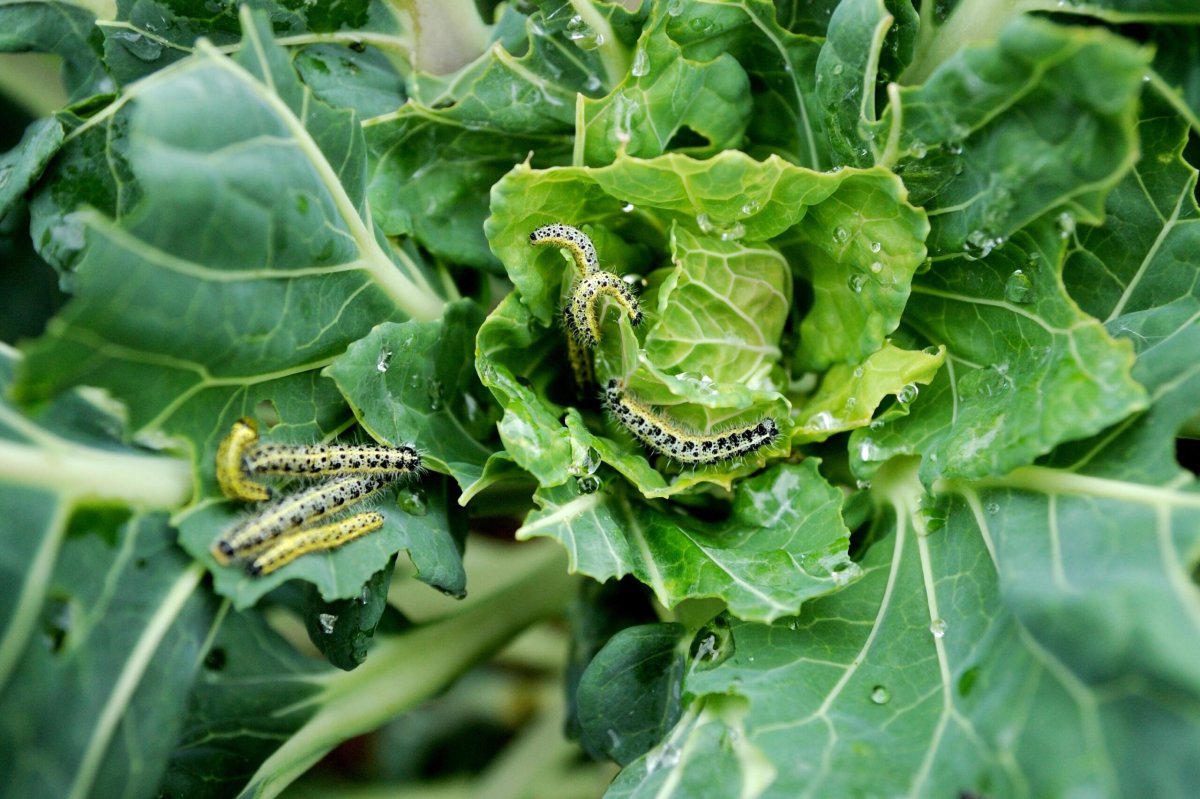

We may earn revenue from the products available on this page and participate in affiliate programs. Learn More ›
Beautiful buds, glossy leaves, and healthy robust vegetable plants are the pride of any gardener. But what do you do when the glory of the garden is cut short by a common garden problem: a major bug infestation? The good news is, not all garden bugs are bad. In fact, even some of the most common garden bugs can also have some benefits. However, if you find your plants are looking a little worse for wear, you’ll want to learn how to get rid of bugs without causing damage to your plants or the environment.
Because many of these insects thrive on new seedlings and plant growth as well as fresh fruit crops, many types of plant pests can be found in the garden from mid-to-late spring all the way into the early fall. This list of common garden pests should help the home gardener identify garden bugs and learn how to control them.

1. Ticks
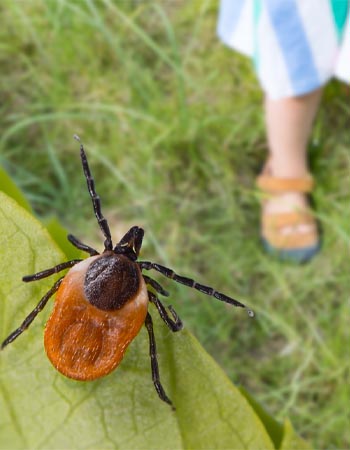
Ticks are tiny little arachnids that are usually dark brown or black. To the untrained eye, they may even appear to be small spiders, which they are related to. Adult ticks have eight legs (larvae have six). These common garden pests are parasitic crawlers that attach themselves to people and pets to feed on their blood. Ticks can be as small as a sesame seed and swell to the size of a raisin or bigger when fully engorged. Unlike fleas, ticks do not jump. The initial bite is frequently painless, which leads to ticks going undetected for several days as their bodies slowly engorge with the blood of their victim. As they feed, the victim’s skin can become inflamed or itchy, or there may be other more intense symptoms like fever or a rash. Ticks can carry diseases such as Rocky Mountain Spotted Fever and Lyme disease. Although ticks are most active in the summer, they can be found in the late spring through the fall and even in the winter in many climates.
While ticks do not cause any damage to plants and are nearly undetectable in the garden, they are a huge nuisance to people. They prefer moist or damp wooded areas, but they also love to live on grass such as a front lawn. In addition to inspecting pets and people for ticks after spending time outside, and using spray tick repellents, the secret to keeping ticks off your grass is to maintain a healthy lawn. Keeping the grass mowed and free of debris can help keep ticks at bay. Tick-specific chemicals, called acaricides, can be sprayed on a lawn sparingly in the spring and again in the fall to try to control ticks that carry Lyme disease. Wild animals sometimes become carriers of ticks, so using fencing to keep woodland critters out of your yard can also cut down on ticks in the garden.
- Looking to get rid of ticks? Check out Sunday Lawn Care’s Nix Ticks solution
2. Fleas
Like ticks, fleas are tiny garden bugs that bite and feed on blood. Flea bites can cause skin rashes in both pets and humans. To the naked eye, fleas can look like little more than dark specks about ⅛ inch long. The main way to tell if the insect you’re trying to identify is a flea is by observing if it has the ability to jump quite high (since fleas have powerful hind legs). Fleas are active year-round, especially if they can manage to make it indoors.
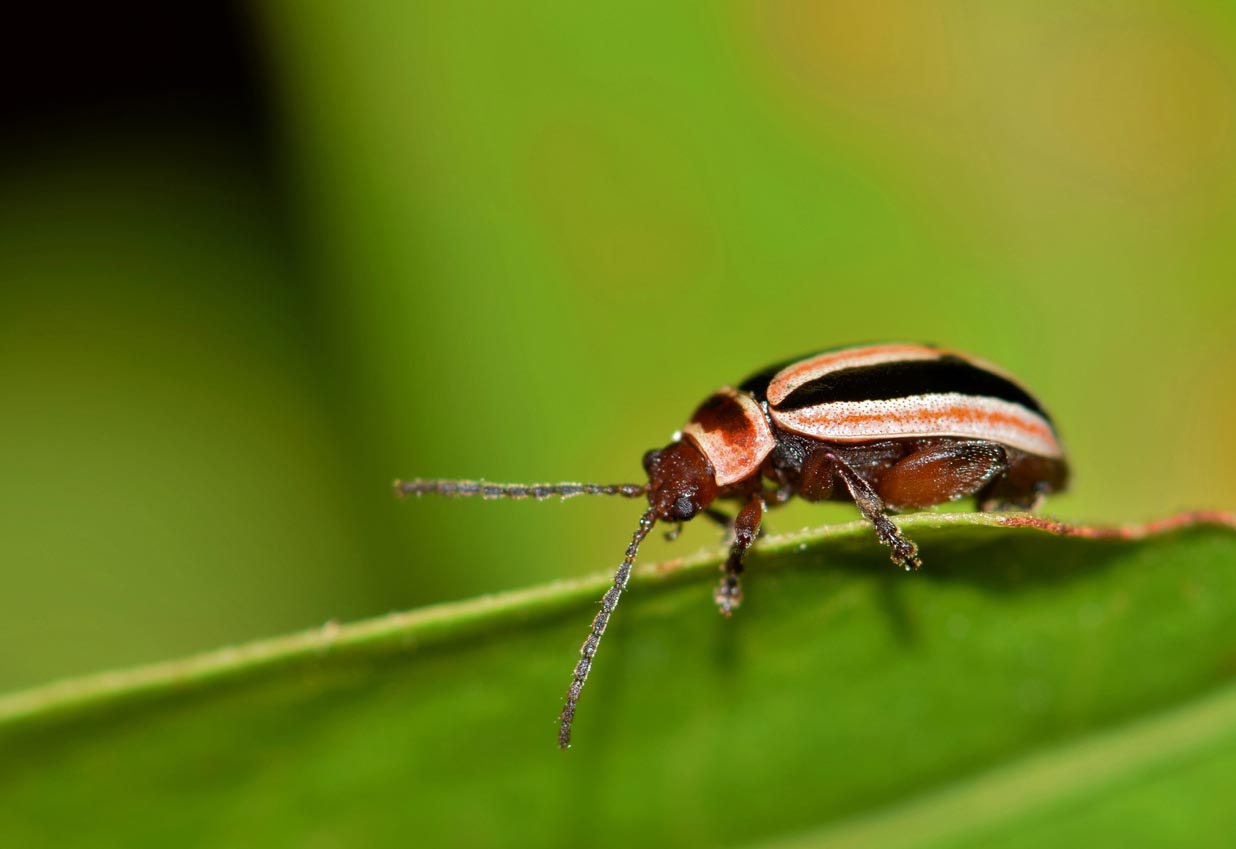
Fortunately, fleas do not cause specific damage to plants or lawns, but they can be difficult to spot in advance. It’s common to not even notice a flea until one bites. Outdoors, fleas tend to like damp shady spots, anywhere a pet sleeps, or any place frequented by wildlife such as squirrels or raccoons. Treating pets directly to repel fleas is the most effective way to avoid an infestation, especially indoors. However, if fleas are a consistent problem there are a few nontoxic and chemical insecticides that can be applied to lawns and areas under trees or bushes where it is shady or damp. Many of these are formulated to repel fleas and ticks.
3. Ants and Fire Ants
Ants are some of the most industrious of the garden insects. Be sure to identify garden bugs such as ants correctly, as there are a number of species that are harmless, and in fact helpful to the yard and garden (these are the 10 types of ants every homeowner should know about). Ants are divided into “one-node” or “two-node” species, and they can vary in color from pale amber to red to brown to black. Though ants themselves do not necessarily harm plants, leaf damage identification can lead back to ants. Some species of ants “farm” aphids or other sap-sucking insects, which can cause leaf damage. In most cases, rather than treating the ant, it’s best to treat the insect that is the problem (such as aphids). Ants tend to be most active in the spring and summer months.
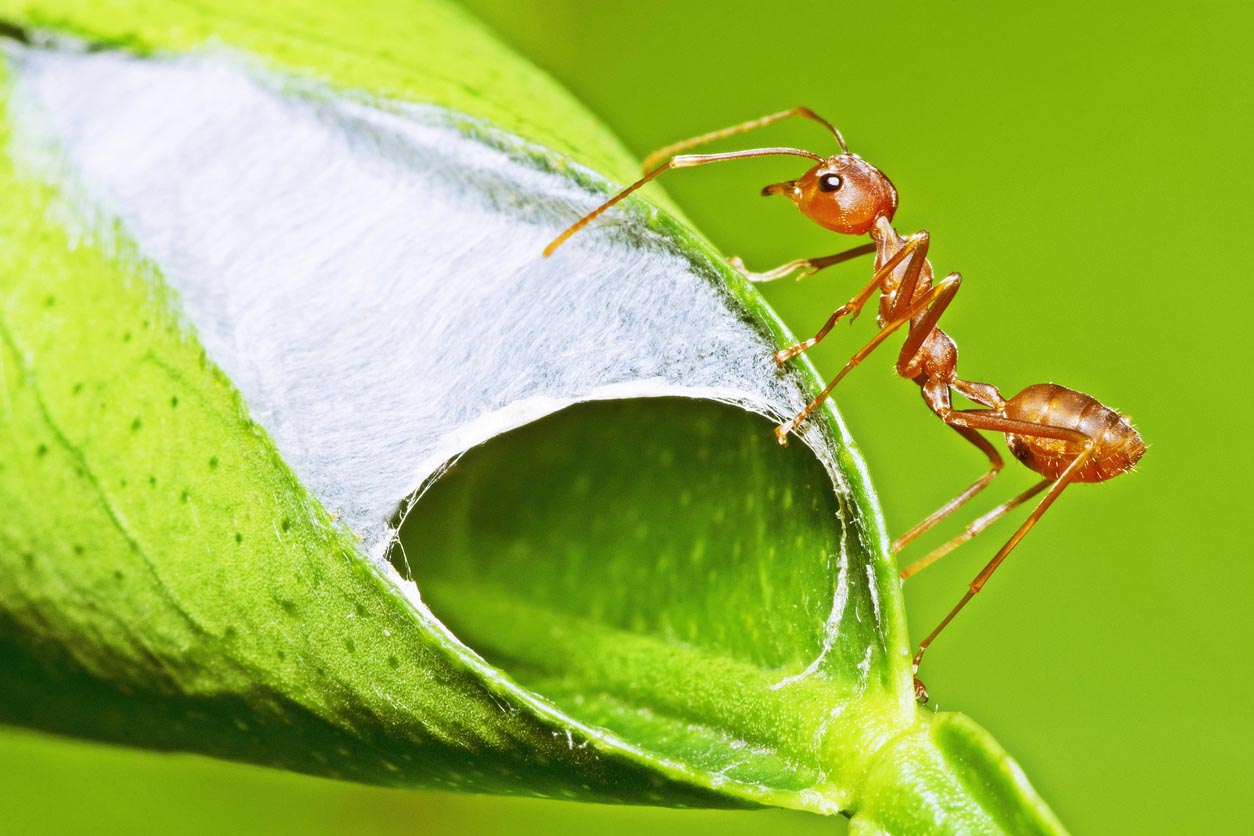
While having ants inside the home can be a nuisance (ants in the kitchen can be particularly frustrating), ants in the garden are usually not a problem and should be left alone, with a few exceptions. Fire ants, harvester ants, and Allegheny mound ants are not necessarily biologically damaging to the garden, but these types of ants bite and they can be a very unwelcome pest in the yard, especially in a lawn where people spend time relaxing. Fire ants in particular are aggressive when nests are disturbed, and disturbing them is easy if there are nests scattered throughout a lawn. Similarly, Allegheny mound ants can be aggressive when disturbed. Harvester ants are not as aggressive, but they do produce a painful stinging bite. All three of these ants are usually first detected by the small mounds that pop up as a result of the underground nests. Avoid disturbing a nest or walking on one; ants are quick and can cover a leg in seconds. Fire ants thrive in southern lawns. Harvester ants also like warmer temperatures, above 60 degrees, so they are also often found in warmer climates year-round. Allegheny mound ants can be found in North Atlantic areas as far north as Nova Scotia and as far south as Georgia.
- Looking to get rid of ants? Check out Sunday Lawn Care’s Ant Adios and Fire Ant Fighter solutions
To prevent ants from coming inside, keep areas around doorways and windows free of debris, promptly clean up food or sugary drinks, and keep screens closed. Make sure entryways are well caulked and sealed to cut down on entry spots. Keep trash and recycling bins away from the home and periodically rinse them. Sticky traps can be placed near entry points and around the bases of large trees or shrubs. There are some insecticides on the market that are less toxic and can be sprayed sparingly to prevent an ant infestation too close to the home.
For a fire ant infestation (or an infestation of a similar aggressive ant), treatment usually involves using bait. A small amount of poisonous bait is placed near the mound. The ants bring this back to the colony and slowly, over a period of several days or longer, the entire colony is killed off.

4. Mosquitoes
Of all the outdoor pests, the mosquito is probably the most recognizable in spite of its tiny size: most are smaller than ½ inch long. The two most common types of mosquito in the United States are the Northern house mosquito, which is brown, and the Asian tiger mosquito, which has black-and-white stripes on the body. While spotting a mosquito in advance isn’t always easy, the telltale high-pitched sound mosquitoes make is usually a giveaway. Like fleas and ticks, they suck blood, and reactions to their bites range from itching to swelling. Excessive scratching can lead to bleeding and skin infections. Mosquitoes and summer go hand in hand, but many climates have mosquitoes in early spring to late fall. In some places, mosquitoes can be year-round pests.

Mosquitoes do not cause any specific problems to plants in the garden, but they can make spending time outdoors intolerable. Apart from applying mosquito repellent when going outside, there are a few other preventive methods that work in tandem to help control mosquitoes in the garden. Mosquitoes reproduce by laying eggs in water, so don’t let water sit for too long. Regularly check pet bowls, bird baths, flower pots, rain barrels, kiddie pools, gutters, and any other potential source of standing water. Make sure irrigation systems work well and that lawns and other garden beds have drainage and no standing water. Outdoor fountains or waterfalls have circulating water, which mosquitoes don’t like for laying eggs, but introducing mosquito-eating fish or frogs into fountains and ponds creates natural mosquito control. Mosquitoes like cool, damp environments, so avoid overwatering, especially in shady areas. Some mosquito control products can be placed in water to control breeding. There are a few mosquito-repelling plants, such as pennyroyal, citronella, and scented geraniums, which can be planted near patios and outdoor seating areas to help reduce mosquitoes in the immediate area. Certain spray treatments and chemicals can also be applied outdoors to control mosquitoes in areas where people like to spend time.
- Looking to get rid of mosquitoes? Check out Sunday Lawn Care’s Mosquito Deleto solution
5. Crickets
Crickets are common garden insects known for a chirping sound that for many is synonymous with late summer nights. As part of the same family as grasshoppers and locusts, crickets are sometimes confused with both. The two most common types of cricket are the house cricket and the field cricket. House crickets are brown, grow to about ¾ inch in length, and have wings. The field cricket is between ½ and 1 inch long, has wings, and is shiny and black. Generally speaking, most crickets stay under 2 inches in length. Crickets also have large rear legs for those powerful leaps.
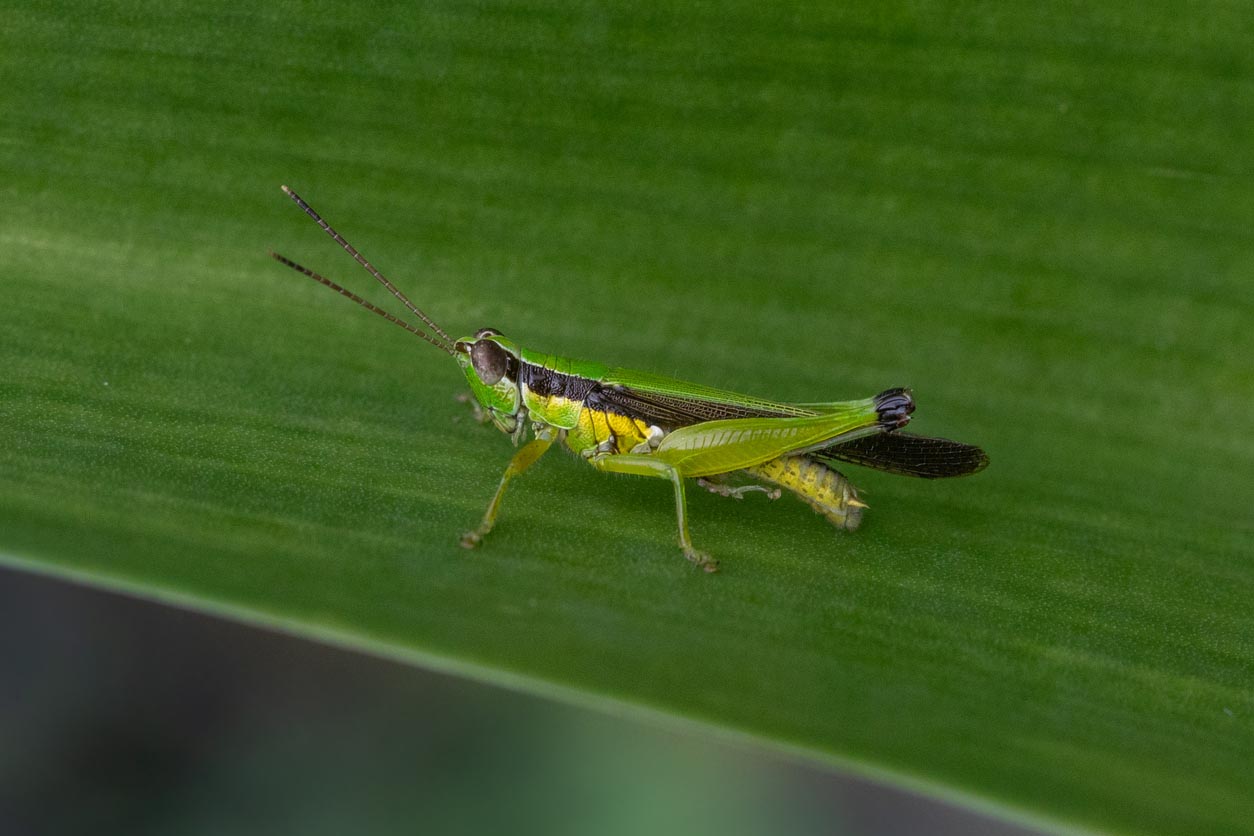
As a beneficial insect in the garden, crickets eat insects such as aphids and mites and, according to the University of Michigan, are weed seed predators. This means they consume weed seeds and cut down on the spread of weeds. Crickets are omnivores, so they will also munch on garden plants. Of all the leaf-eating insects, though, crickets do minimal damage. However, larger populations of crickets will cause more noticeable damage.
In the Southeastern U.S., mole crickets are a major problem. Unlike their more common cousins, mole crickets can devastate lawns. They uproot grass by making tunnels, disturb the soil, and eat grass and its roots. To determine what type of soil bug you’re dealing with, look for insects that resemble crickets but have an odd, squished mole-like head. Adult mole crickets are typically between 1 and 2 inches long with large claw-like front legs to help them dig in the ground. Lines of pushed-up grass or soil along the lawn are signs there could be a mole cricket infestation.
Getting rid of crickets, including mole crickets, can take some time. Clemson Cooperative Extension recommends the following: Clean up places they like to hide such as leaf piles, stacks of wood, or other plant debris; be sure the soil is nutrient rich; keep the lawn at the correct height and practice regular lawn care including fertilizing and irrigation. For added control, trying a soapy water drench before resorting to heavier insecticides can be an effective method.
6. Earwigs
Earwigs are easily spotted thanks to the pincer-like appendages that extend off their abdomen, which gives them their second name, pincher bugs. Usually around ½ inch long and brown in color, these garden insects are incredibly common and not all bad. Earwigs feed on insects that damage garden plants, such as aphids. Unfortunately, earwigs are flower-eating bugs, feeding on flowers and the tender growth of plants. Their damage is obvious, as the little pincers quite literally take bites out of petals and new leaves, and the munching is often in a jagged, irregular pattern.
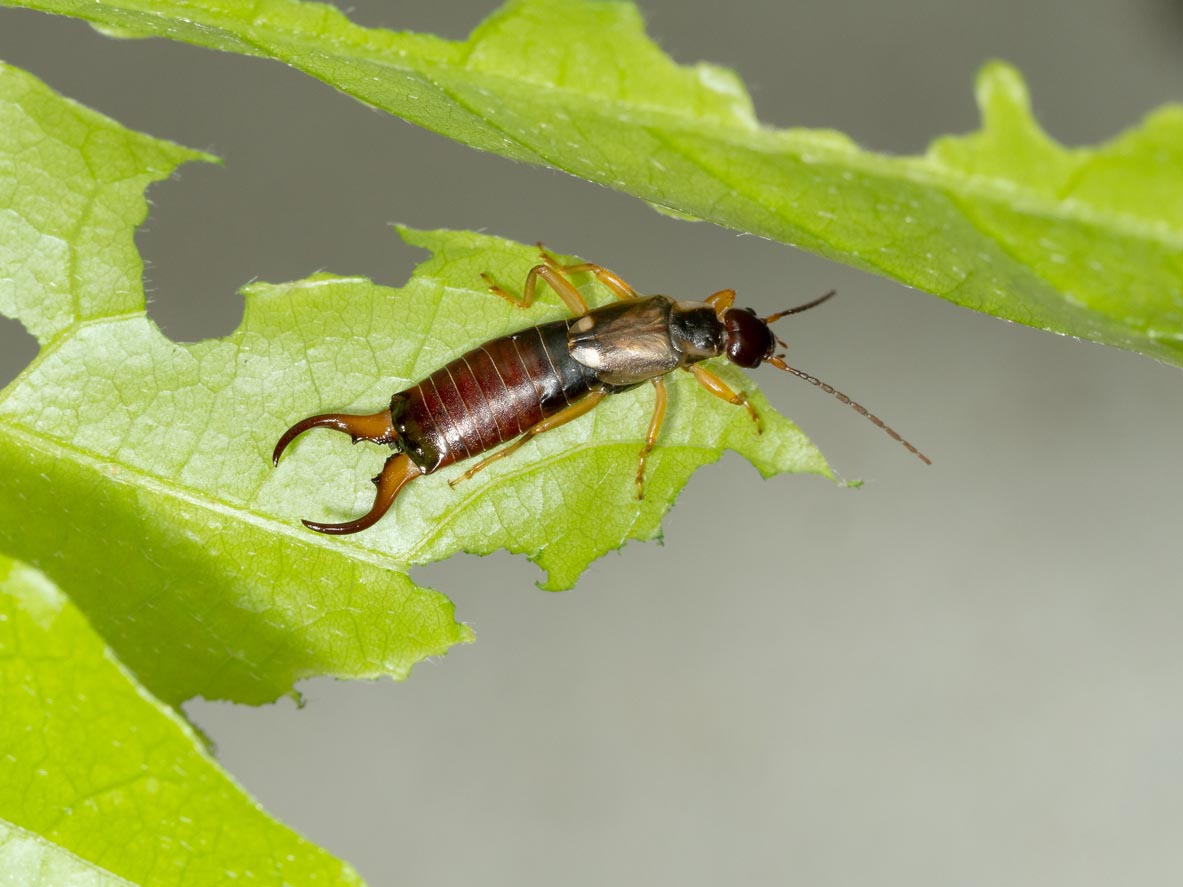
Eliminating beneficial predators entirely such as earwigs and crickets can cause more harm than good, signaling to pests like aphids that the territory is all clear. Still, a larger earwig infestation is unpleasant and leaves behind enough damage to warrant population control. According to the University of Minnesota Extension, earwigs love damp, dark places and are most active at night. There are a number of natural ways to get rid of earwigs, such as rolling up newspaper, keeping it damp, and placing it at the base of problem plants. Once the earwigs have been trapped, drown the insects in a soapy water solution. Chemical solutions are usually not necessary, but pyrethroids are usually effective.
7. Grasshoppers
Grasshoppers are in the same insect order as crickets and locusts (Orthoptera) and are sometimes confused with crickets. Though there are differences between grasshoppers vs. crickets, it takes a closer look to be sure. Generally speaking, grasshoppers are slightly larger in body size, from ⅓ inch all the way up to 4 inches in size, whereas crickets never get larger than 2 inches. Both crickets and grasshoppers can be brown, but grasshoppers are darker brown as well as green. They also have large hind legs to help them “hop” from place to place.
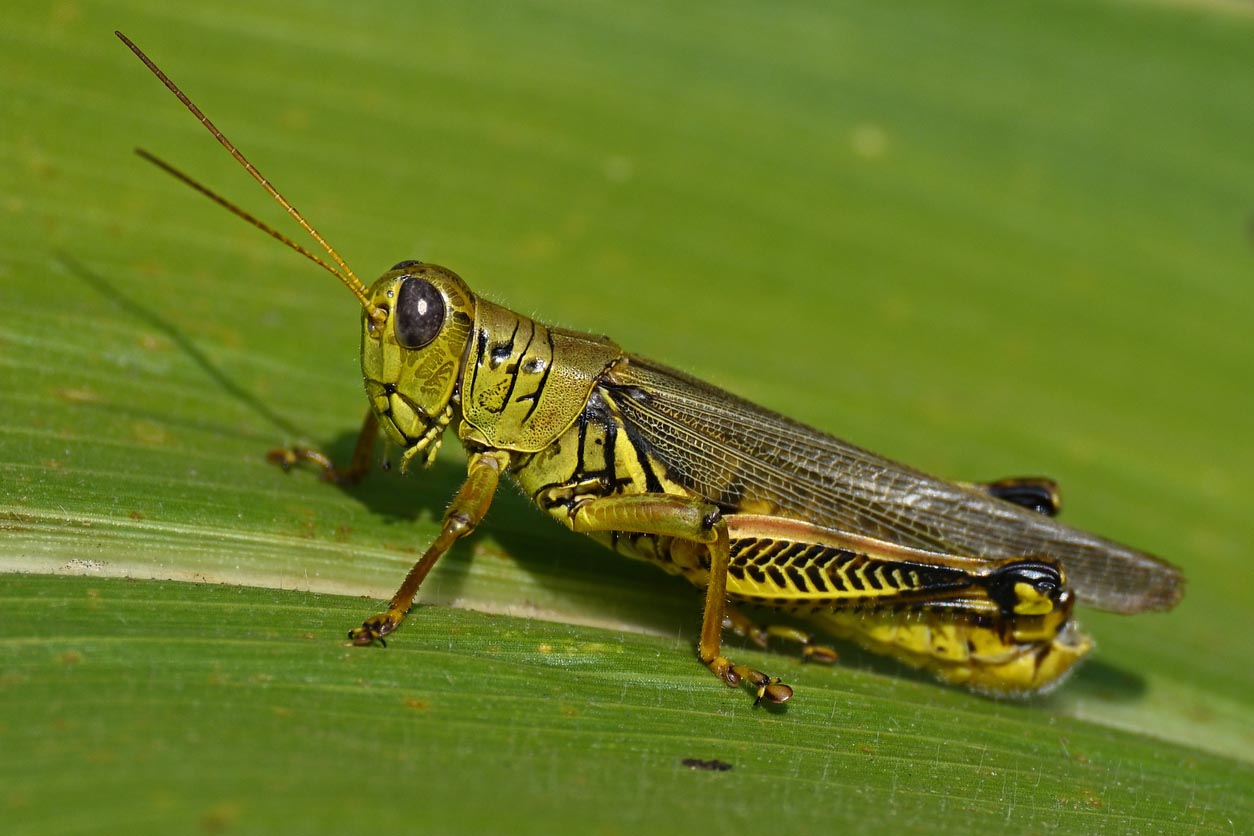
Like crickets, in small numbers, grasshoppers cause minimal damage in the garden. In fact, their excrement can act as a fertilizer for the soil. When warm, dry weather hits, grasshopper swarms can come rolling in, devastating crops and gardens. Major insecticides don’t necessarily control grasshopper populations; one of the best ways to get rid of grasshoppers is to attract natural predators, such as lizards, birds, and spiders. Preventive measures such as planting marigolds, daisies, and alyssum will attract insects that will attack grasshoppers. Keep the garden free of weeds to help eliminate places where grasshoppers like to hide. Some gardeners have found success by using a mild soapy water solution.
8. Aphids
Aphids are soft-bodied, sap-sucking insects that feed on all parts of a plant including the roots, leaves, stems, and petals. Though they are tiny, they can do a significant amount of damage and spread quickly. They can be black, brown, white, pink, or green and look like little specks the size of sesame seeds. They drain the sap directly out of leaves and can spread viral diseases. If you notice wilting leaves, dried-out leaves, sticky substances on leaves, or a soot-like smudge, these are all signs of an aphid infestation.
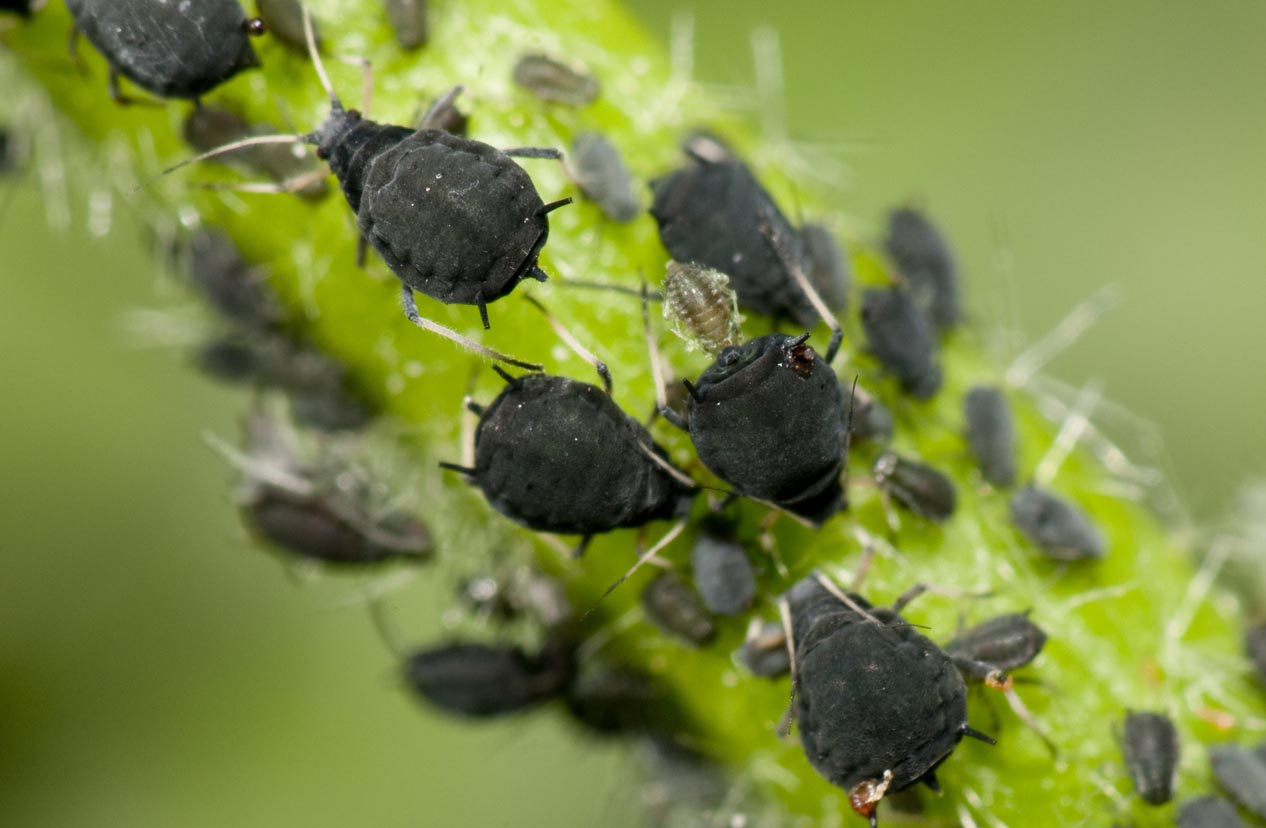
Overfertilization can attract aphids, so taking it easy on the fertilizer throughout the season, especially quick-acting water-soluble growth formulas, is recommended. Invite and introduce beneficial insects that eat aphids, such as ladybugs and lacewings. Additionally, planting bug-resistant flowers can help cut back on aphid infestations. If there are a lot of aphids, try using a soapy water solution made from a few drops of dish soap added to a gallon of water and spray the entire infested plant, including the undersides of leaves. There are other insecticides you can use, but the soapy solution usually controls aphids in conjunction with other preventive measures.

9. Caterpillars
Caterpillars are the larvae of butterflies and moths, and they can munch the leaves, stems, shoots, and fruit of plants, leaving substantial damage in their wake. Perhaps the most disappointing is that caterpillars are among the many flower-eating bugs and can ruin a beautiful crop overnight. Look for jagged bite marks in leaves or petals or holes in fruit. Keep in mind that butterflies and moths are significant pollinators in the garden, so insecticides that eliminate the population should be avoided. Fortunately, most plants can take a little leaf damage and continue to thrive. The two best ways to control caterpillar damage are removing the caterpillars by hand and encouraging creatures that snack on caterpillars, such as reptiles, small mammals, birds, wasps, and amphibians.
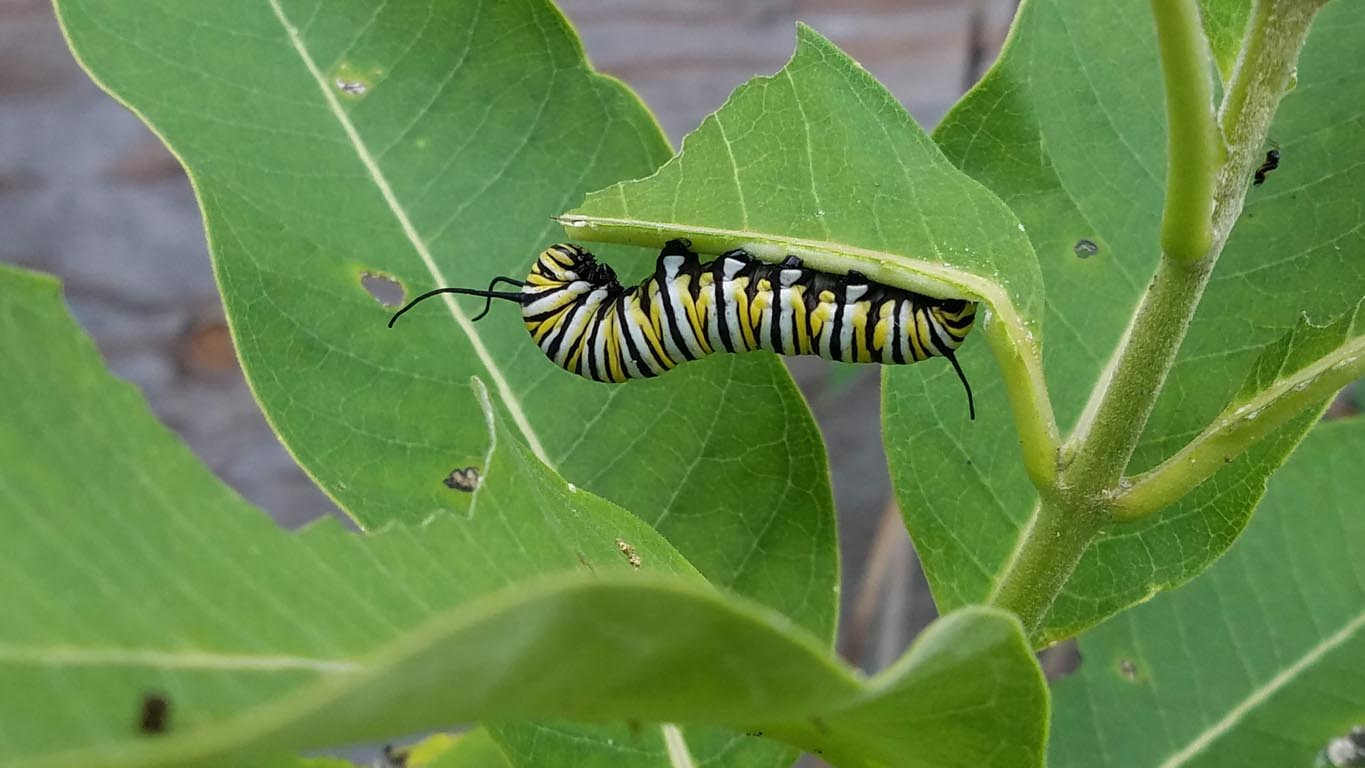
Some caterpillars can do more damage than just a few bites. Tomato and tobacco hornworms love plants in the nightshade family, including tomatoes, peppers, potatoes, and eggplants. A telltale sign of these hornworms is leaf damage along with a trail of small, dark pebble-like excrement. These types of caterpillars are lime green with white V-shaped markings and a horn shape at the end of their body. They can be removed by hand for damage control. However, if rice-like white growths are spotted on a hornworm’s body, these are the cocoons of parasitic wasps that will eat the hornworms. These wasps are harmless to humans and pets.
10. Cabbage Maggots
Although they are named for the cabbage crops they destroy, cabbage maggots prey on all of the members of the Brassica family including cabbage, broccoli, and cauliflower as well as other root vegetables such as carrot, parsnip, rutabaga, turnip, and radish plants. According to the University of Massachusetts Extension Vegetable Program, the first sign of these detrimental insects is wilting plants on a sunny day followed by the outer leaves turning yellow or purple. This is then followed by collapsing plants that wilt and ultimately die. Upon inspection of the plant, there will be wriggling, white maggots tunneling into the roots or the root vegetable, leaving considerable damage and leaving the plant inedible.
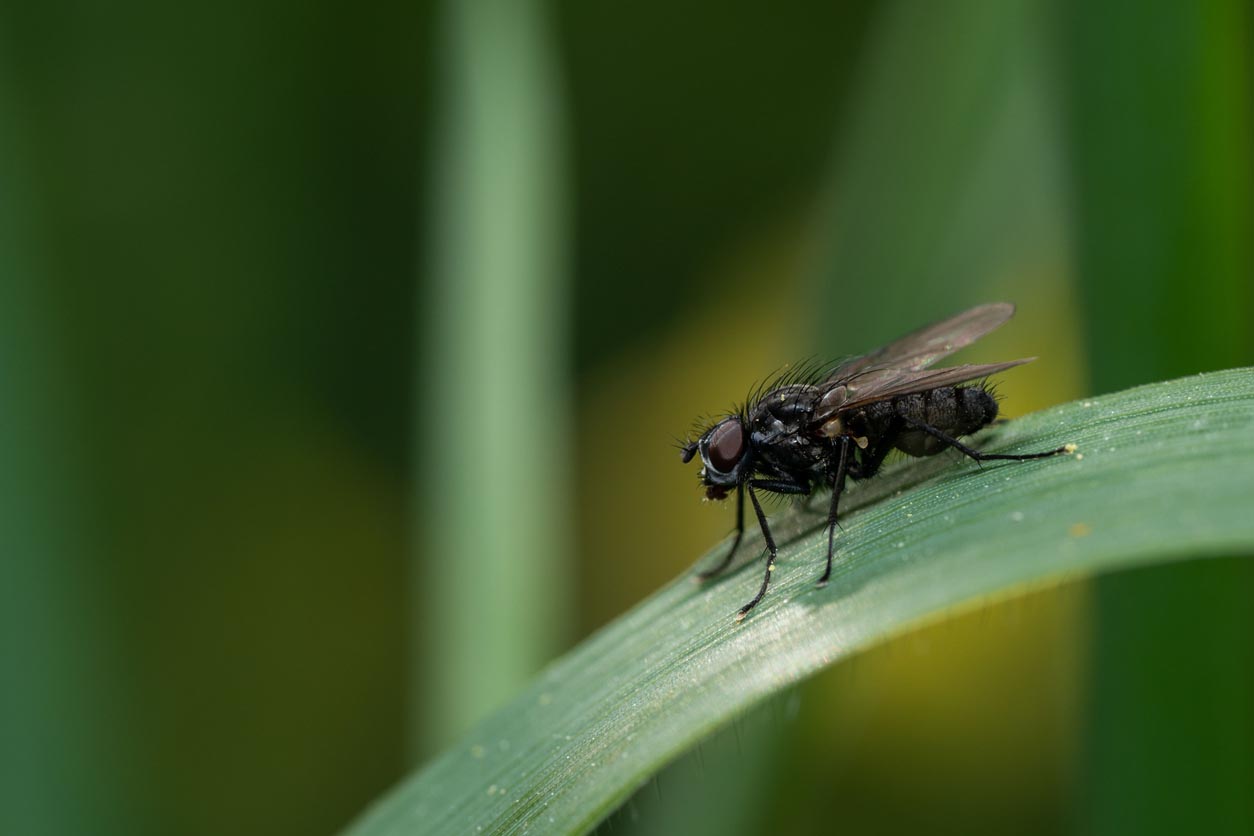
A critical component for avoiding an ongoing infestation is to never plant a crop of the Brassica family in the same spot in consecutive years. If there has been an infestation of carrots or similar plants, crop rotation is recommended. Cabbage maggot flight is typically mid-May, so plant crops later into June. Soil temperatures above 95 degrees will kill off eggs. There are insecticides that can treat major infestations, though practicing sustainable crop rotation and planting cool-season vegetables at the correct time of year for the climate you live in is typically enough to control these maggots.
11. Cutworms
Cutworms are a particular kind of caterpillar that can do some serious damage to favorite vegetable crops in a short period of time. These little caterpillars are typically less than 2 inches long and can be green, gray, yellow, or brown. If they curl up into a “C” shape when you touch them, they’re likely cutworms.
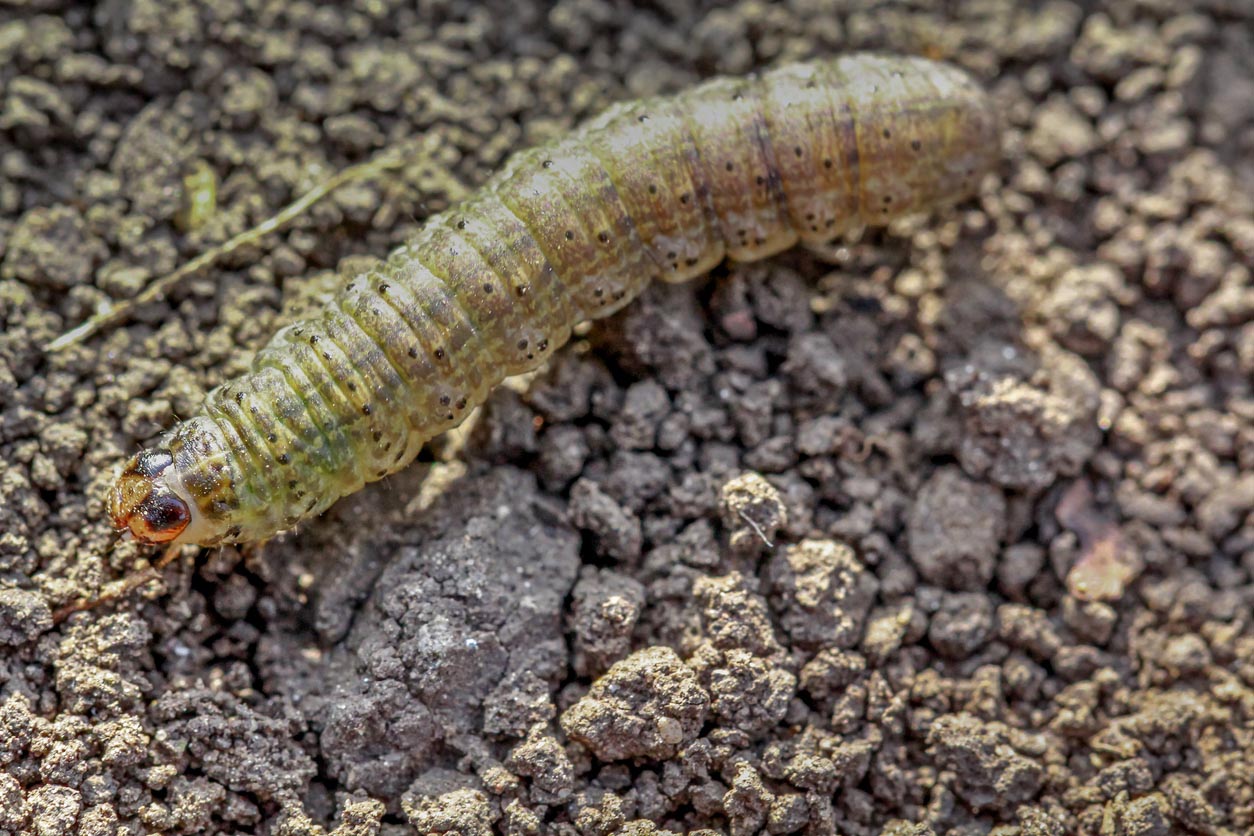
Cutworm caterpillars live in the top layer of soil and can devour newly sprouted seedlings, which is a discouraging sight for any gardener. Natural methods of control include protecting seedlings with small collars of cardboard or aluminum foil, inserted just below the soil. A nontoxic and inexpensive method of control is to leave out small bowls with wheat bran or cornmeal, which cutworms cannot resist—and cannot digest. Eating wheat bran or cornmeal will kill the cutworms.
12. Slugs
Slugs slip into the garden under cover of night and wreak havoc on plant leaves. Telltale signs of slug damage are leaves that have been eaten and a trail of slime. Slugs and snails have similar habits: Both like to eat young plants and soft leaves like hostas, and both leave that signature trail of slime. Since slugs like to come out after dark, visit the garden at dusk to try catching these slimy creatures in the act. Slugs can be yellow, gray, orange, black, brown, or multicolored.
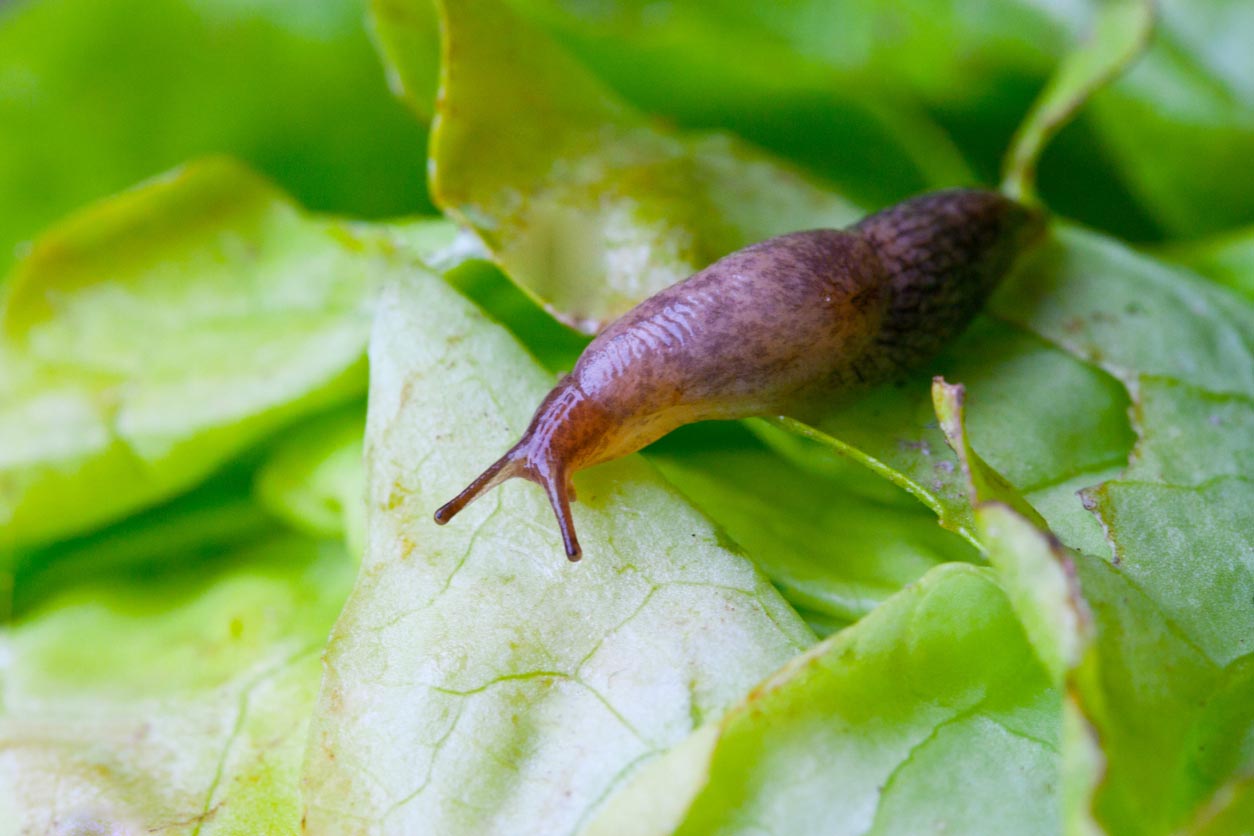
There is a wide variety of nontoxic slug methods that can be used without having to resort to chemicals. Birds and toads love to eat slugs, so poisoning slugs with chemicals means you are poisoning the food source for these animals. Instead, opt for home remedies. Place copper strip barriers sold at garden centers for this purpose around vulnerable plants or sprinkle diatomaceous earth in areas surrounding the garden beds. A common and effective method is to place a shallow dish of beer in the garden. Slugs are drawn toward the beer but will drown in it, as long as the dish is deep enough. Refill the beer each night.

Even the Most Destructive Garden Pests Can Be Treated With Safe and Effective Solutions
While these common garden pests can do major damage to garden beds, they are not the only plant bugs of concern. Japanese beetle infestations are becoming more and more common, and the insects prey on the wide, soft leaves of plants such as beans and grapes. They eat around the leaf veins, leaving a lacey husk behind. Very few chemical controls work against Japanese beetles, so hand removal is the most effective method of getting rid of them. Remove beetles and drown them in a cup of water with a few drops of dish soap.
Squash bugs are another difficult bug to control; they prey on pumpkins and squash, burrowing into the fruit and rendering it inedible. Fruit softens instead of ripening. Similarly, the cucumber beetle preys on cucumber and melons. However, before these plants are ripe, cucumber beetles also become flower-eating bugs, devouring dandelions, cherry and apple blossoms, and hawthorn flowers. Pesticides aren’t very effective on squash bugs or cucumber beetles. The best way to control squash bugs and cucumber beetles is to remove the eggs from the leaves before they hatch, either by hand or with blasts of water, and practice crop rotation.
Root weevils are another common garden pest. The larvae bore into and eat the roots of rhododendrons, azaleas, grapes, and other plants. The adult weevils eat the bark, leaves, and flowers of plants. They can be controlled by preventive measures such as keeping garden beds clean of debris and excessive mulch and trapping adults with sticky traps.
Scale are pests that can be either soft or armored, i.e., hard-shelled or “scaled.” They suck the juices of plants, leaving foliage wilted and spotted with yellow, brown, or black. If left unchecked, a sticky sap will appear on the wilting leaves. Frequently seen on the undersides of leaves and along stems, they can be scraped off by hand if there are only a few. Heavier infestations should be treated with a mild insecticidal soap or dish soap solution.
Flies may not seem like an issue for the garden, but flies that eat plants do exist. These include whiteflies, fruit flies, and bulb flies. Depending on the type of fly and the stage the insect is in, different parts of a plant fall prey: larvae tend to feed on roots, for example, which can severely stunt the growth of the plant. Introducing predatory bugs in the garden, such as ladybugs, can help control the population of flies.
Bugs, including these common garden pests, are part of the biodiversity of a garden, and mass eradication with harsh chemicals such as those in many commercial insecticides can cause more damage than good. A pest-free garden may be an impossible goal, but it can also be an undesirable one. Many beneficial insects prey on the pests that prey on plants and can create a natural food chain. Should the infestation get out of control, it’s a good idea to consider hiring one of the best professional pest control companies to be sure application of any treatment is done responsibly. Alternatively, consider one of the best DIY pest control solutions for getting rid of bugs on plants: Sunday is a top option that uses ingredients that gardeners can feel good about.
Overall, reducing the presence of unwelcome, plant-damaging bugs can be achieved by using a holistic range of methods. These include planting more disease-resistant plants, including plants that are native to specific climates, which will prove naturally resilient. Companion planting is a sustainable practice that can also have big perks; using plants such as marigolds as a pest repellent comes along with a lovely splash of color. Introducing beneficial insects, attracting pollinators, and encouraging natural predators such as birds and frogs will create a mini ecosystem in your own backyard.

